Inside the Sun
Pankaj Agarwal explores the Sun’s structure and the processes within it
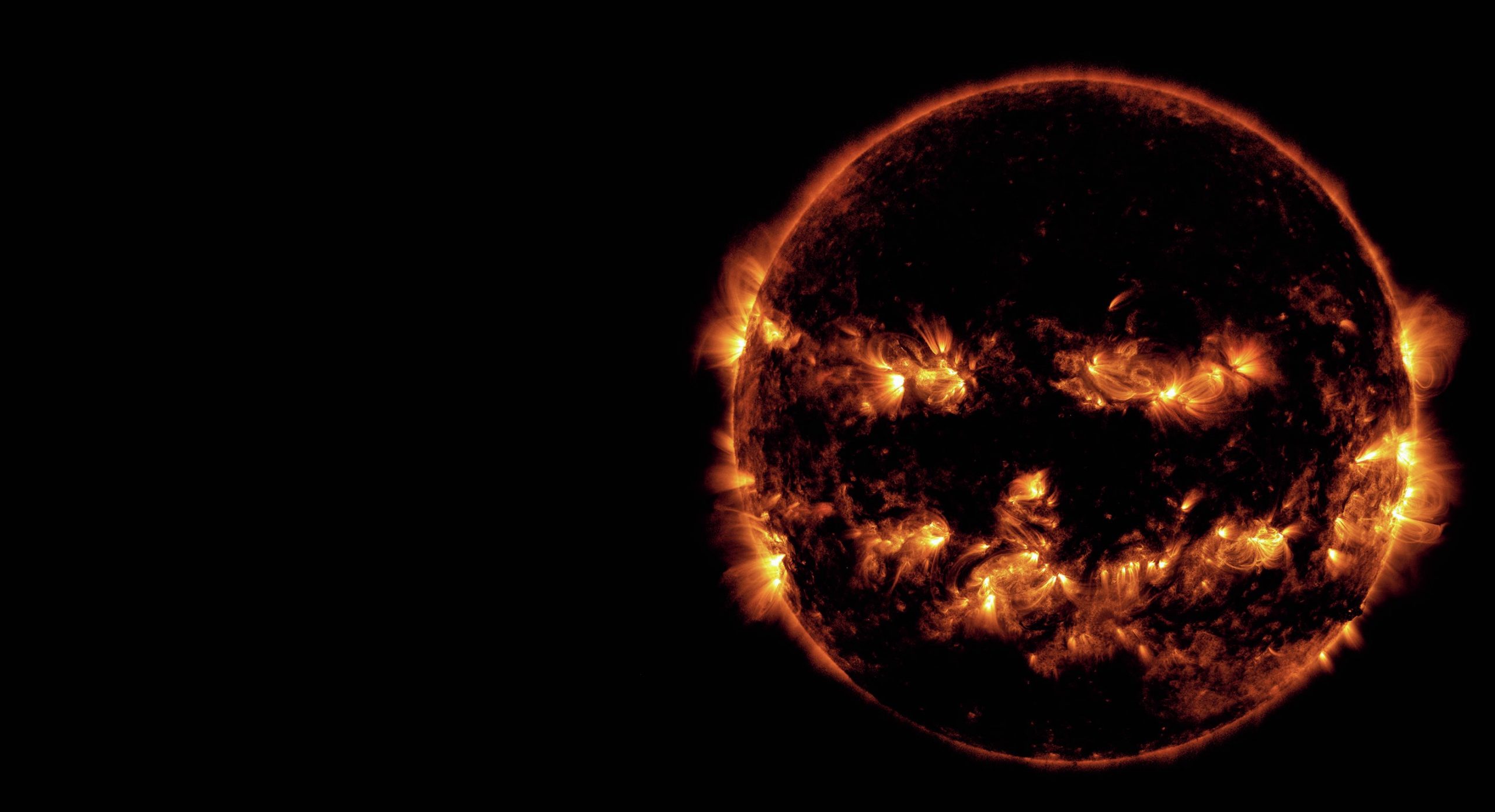
EXAM LINKS
The terms in bold link to topics in the AQA, Edexcel, OCR, WJEC and CCEA A-level specifications, as well as the IB, Pre-U and SQA exam specifications.
In the Sun’s core nuclear fusion produces photons that diffuse in a random walk. The resulting heating drives convection, so hot plasma reaches the solar surface. Interactions between plasma and the Sun’s magnetic field produce sunspots, flares and prominences.
When we look at the stars in the night sky, it is difficult to imagine that the Sun is also a star — a gigantic ball of superheated plasma (ionised gas). It is a main-sequence star, with luminosity, LSun, of 3.83 × 1026W and a surface temperature of 5800K, putting it in spectral class G2 (Box 1). The average lifetime of a G2 star is about 10 billion (1010) years, and the Sun is about 4.5 × 109 years old.
Around 4.5 billion years ago, gas and dust in a cold cloud were pulled together by gravity, increasing the density and attracting more gas and dust to places where the density was greatest. The infalling material would have accelerated and heated up. When the pressure in the centre (core) of the collapsing protostar increased above 2.5 × 1016Pa and the temperature rose to 1.5 × 107K, thermonuclear reactions started, and our Sun was born.
During such a collapse, any small swirling motion speeds up, due to conservation of angular momentum. Consequently, the Sun now rotates with a period of about 27 days.
The Sun’s anatomy
Figure 1 shows the layers that make up the Sun, deduced from modelling and calculations based on observations of the Sun and its radiation.
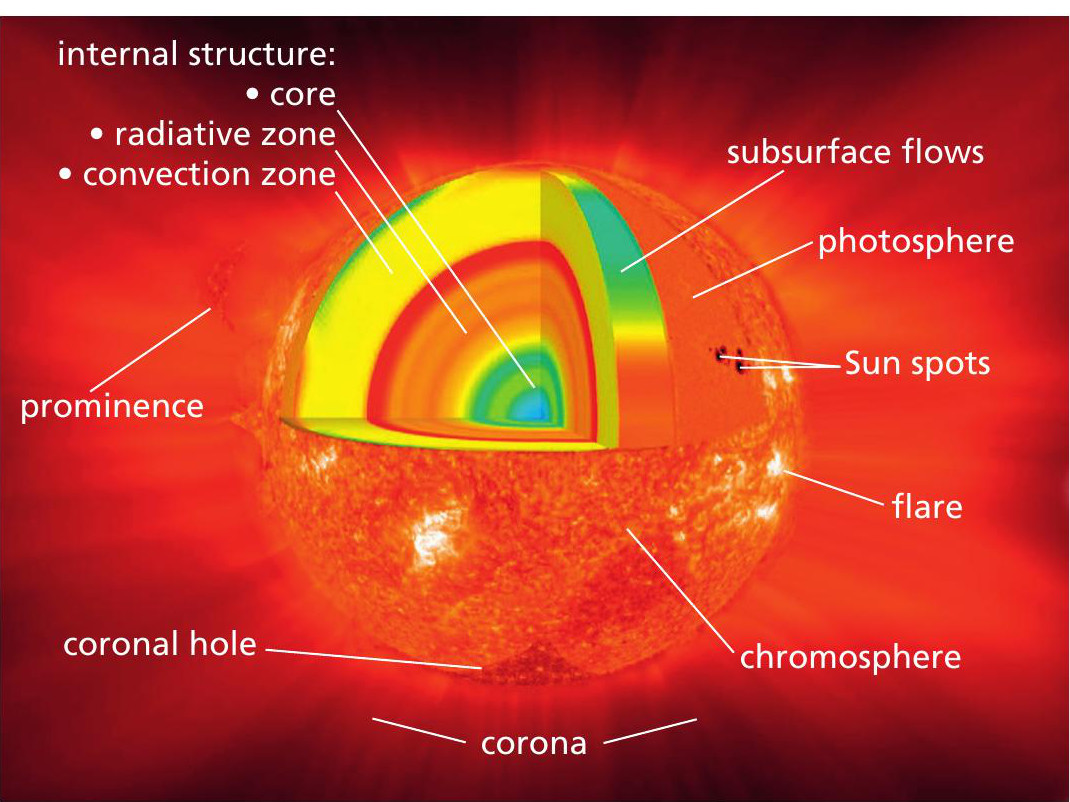
Core
The extremely dense solar core, where the density is around 1.6 × 105kgm–3, contains about half the Sun’s total mass but takes up only about 1.5% of its total volume. Like the cloud from which it formed, the Sun consists of mostly hydrogen and helium, with very small amounts of other elements (O, C, Ne, N, Fe, Mg, Si and S). The core is a mixture of protons, neutrons, nuclei and free electrons.
The core is where the Sun’s nuclear reactions take place. Hydrogen fuses to make helium, and every second about 3.9 × 1038 atoms of hydrogen undergo nuclear reactions and release a huge amount of energy, which eventually escapes as solar radiation.
In the Sun, hydrogen fusion is by a sequence of reactions called pp chains (proton-proton chains). The first step is the fusion of two protons (1H) into deuterium (2H) by emitting a positron (e+) and an electron neutrino (νe). Each deuterium nucleus exists for only about 1 second before fusing with another proton to produce the light isotope of helium (3He) with gamma radiation (γ). There are then three possible paths to generate helium (4He). The overall result is:

The ppI chain (Figure 2) accounts for about 69% of the Sun’s hydrogen fusion. The ppII and ppIII chains involve other nuclei at intermediate steps, but the final result is the same.
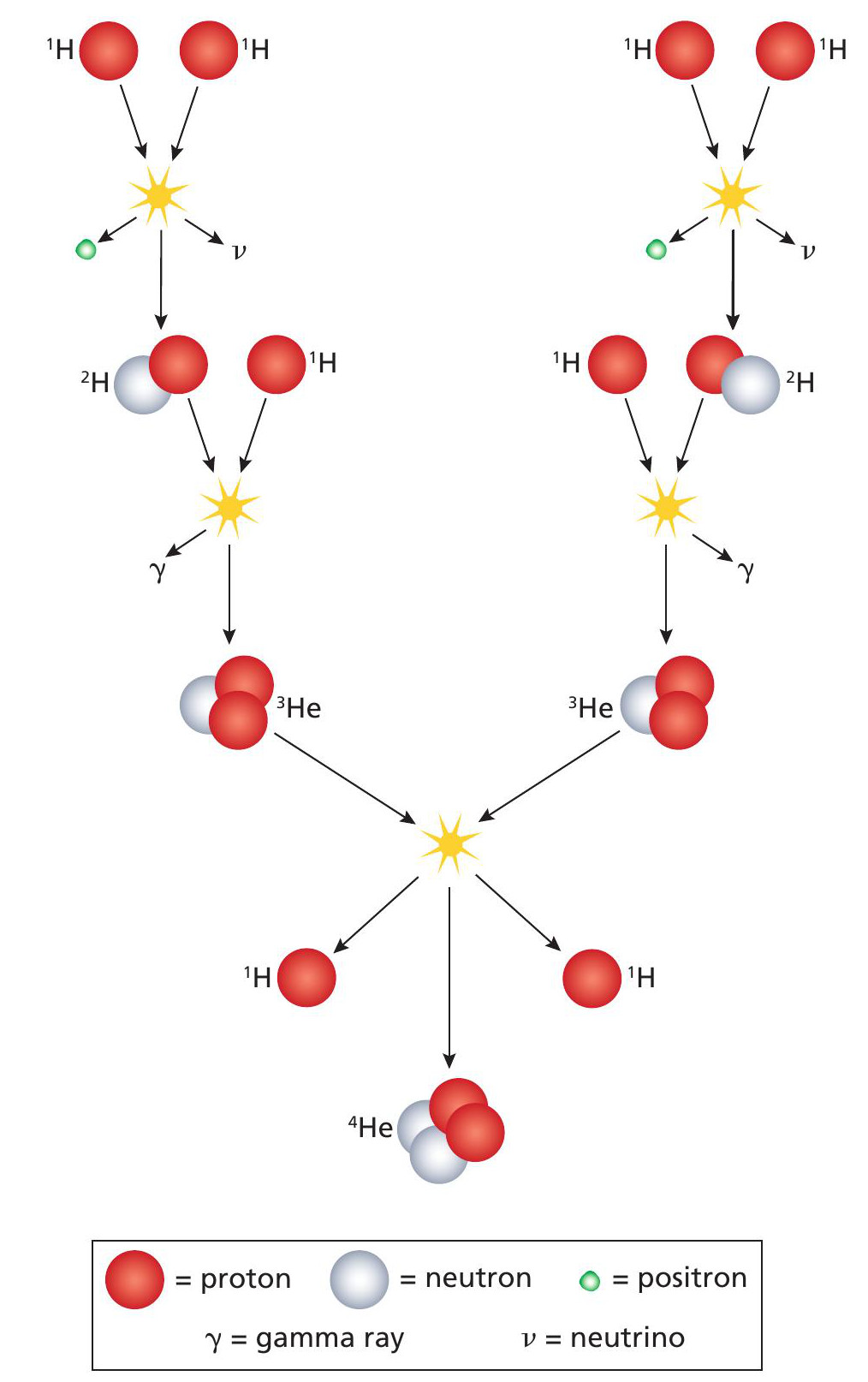
Radiative and convection zones
The layer surrounding the core is called the radiative zone. Here, the energetic gamma rays bounce around between nuclei, causing excitation, followed by the emission of photons with the same, or lower, energy in randomised directions. By this process of radiative diffusion, energy is gradually transferred outwards (Box 2). Also in this layer, some of the loose electrons are captured by helium nuclei (He2+) to form singly ionised helium (He+). The radiative zone temperature is about 5 × 106K.
The next layer, 150000km below the Sun’s surface, is the convection zone. Here, photons from the radiative zone are absorbed by atoms and ions, which raises their temperature. The heated plasma expands and bundles of hot, less-dense material float upwards. The top of the convection layer is where they radiate away their excess of energy, cooling to about 5800 K, becoming denser and sinking again.
It takes about 105 years for energy released by the Sun’s core to reach the top of the convection zone. Most of this journey time is due to the slow diffusion through the radiative zone.
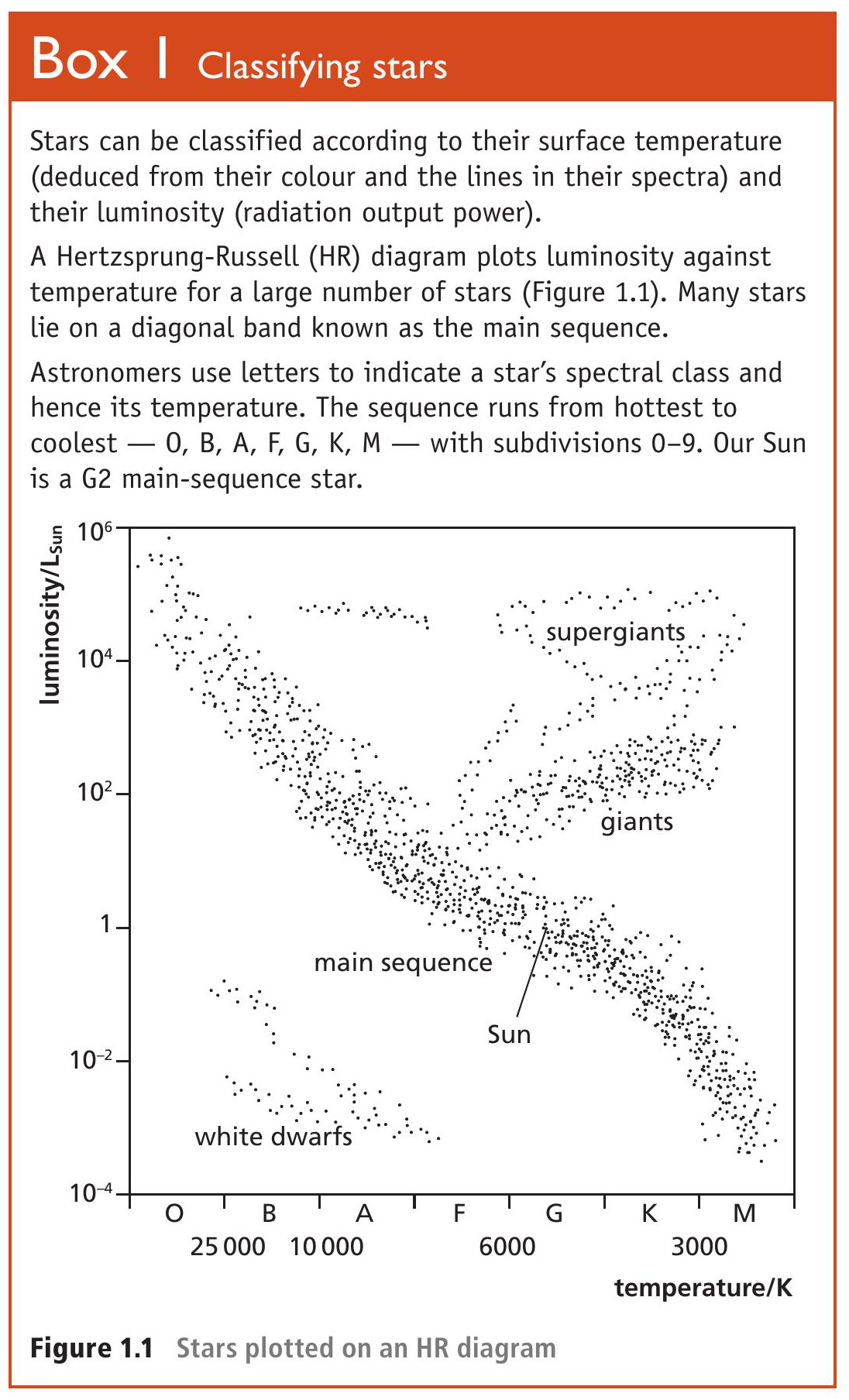
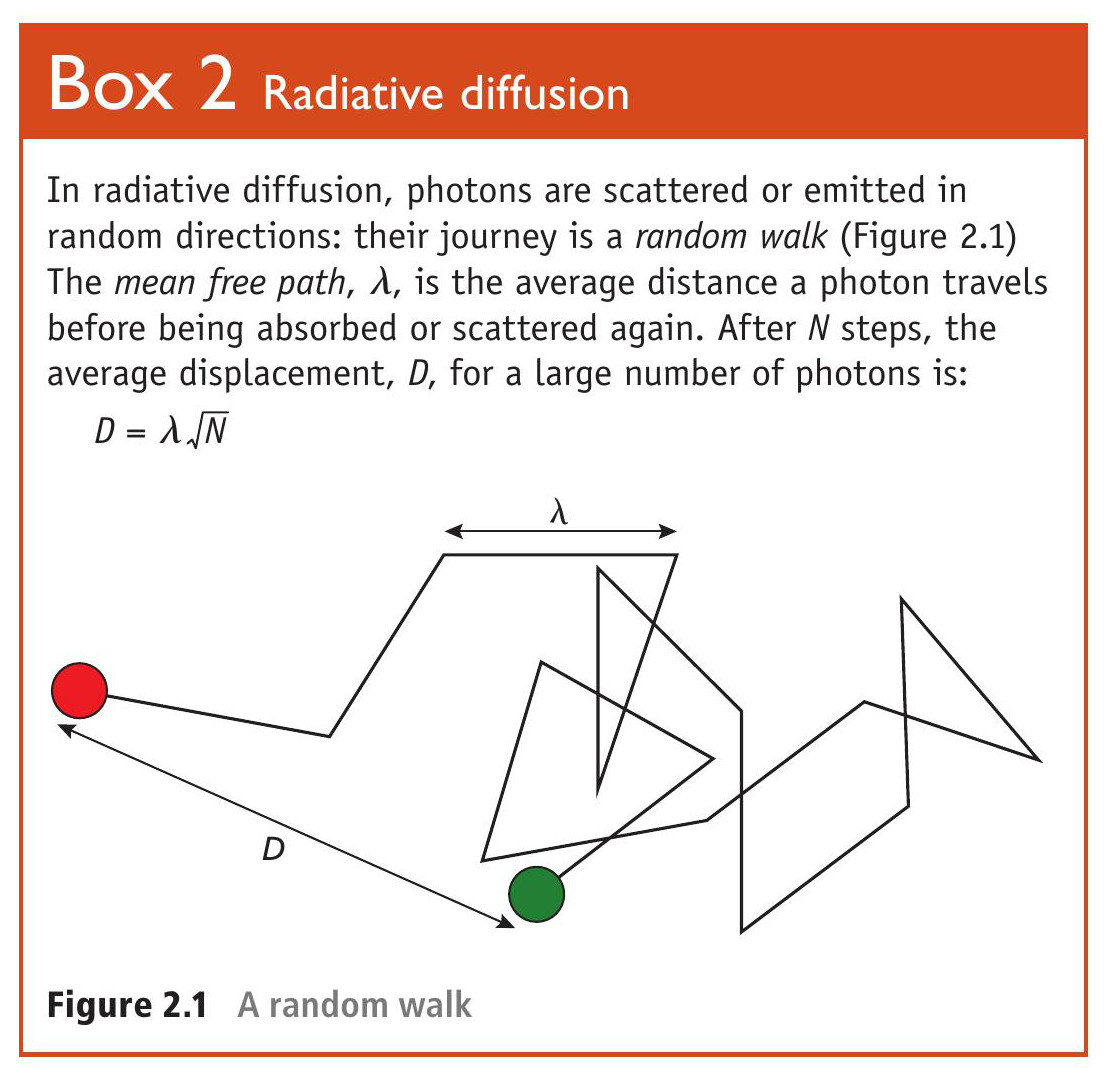
Photosphere
SAFETY NOTE
Do not look directly at the Sun, either with the naked eye or through an optical instrument.
When we see the Sun, we actually observe the photosphere — the sphere of light. Because a star is a large ball of plasma, it has no solid surface. However, there is a depth below which the material stops being transparent to photons, and this depth provides a star’s visual surface. Here the densities are low, so the atoms and ions are unable to block the radiative energy flow. The photosphere is the layer where light escapes into space.
The Sun’s photosphere is about 400 km deep. The temperature in the photosphere is lower than in the convection zone (~5600K).
Atmosphere
Next to the photosphere is the Sun’s atmosphere. The lower part of the atmosphere is called the chromosphere — the colour sphere. It is visible during a total solar eclipse, when the Moon blocks the light from the photosphere. The chromosphere can then be seen as a thin, bright red ribbon that encircles the disc of the Moon. It is a very thick layer, roughly about 2500km, and its temperature rises to 30000K. The chromosphere is more transparent than the photosphere, so normally we see the solar photosphere and not the chromosphere.
The transition region is a thin and very irregular layer of the atmosphere that separates the hot corona from the cooler chromosphere. Heat flows down from the corona into the chromosphere, and in the process produces this thin region where the temperature changes very rapidly.
The outermost part of the atmosphere is the corona (‘crownlike’). Like the chromosphere, it is only visible during a total solar eclipse, which reveals the corona as a luminous white halo surrounding the Sun. The corona temperature rises to about 106K, making it the second hottest part of the Sun after the core (Figure 3). A possible mechanism for the coronal heating is induction by the Sun’s magnetic field and sonic pressure waves from below.
The corona glows because light from the photosphere bounces off free electrons in the coronal plasma. It is much less dense than the photosphere and hence emits less light. The shape of the corona changes with the solar activity cycle. At peak solar activity, it appears as a series of concentric coloured rings around the Sun, with reddish colours in the outer parts. At low solar activity, it is like delicate plumes.
The pressure and density in the corona are much, much lower than in Earth’s atmosphere. It extends millions of kilometres into space, and the outer edge of the corona is constantly being lost. This escaping material is the solar wind — astream of very low-density, hot plasma that travels out through the solar system.
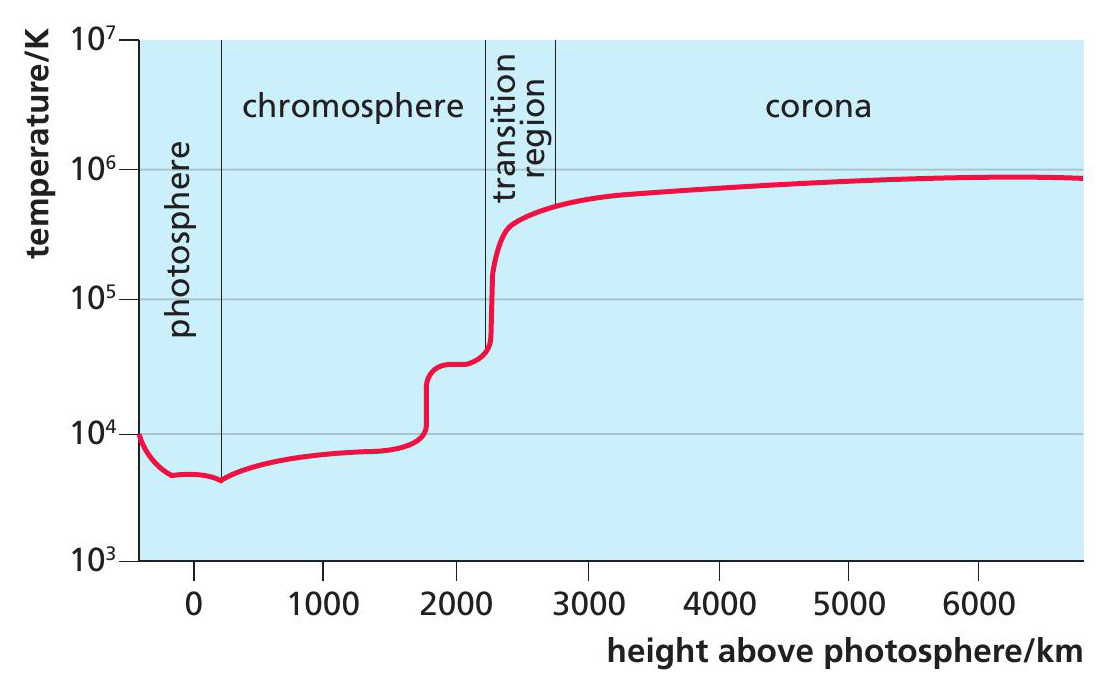
Solar activity
The Sun rotates faster at its equator than at higher latitudes, and its interior rotates faster than the surface. These differences in rotation make its magnetic field lines become twisted together and locked into the solar plasma (Box 3), causing magnetic field loops to erupt from the solar surface and trigger the formation of the dramatic sunspots, solar flares and prominences, which change their shapes and disappear in months or less.
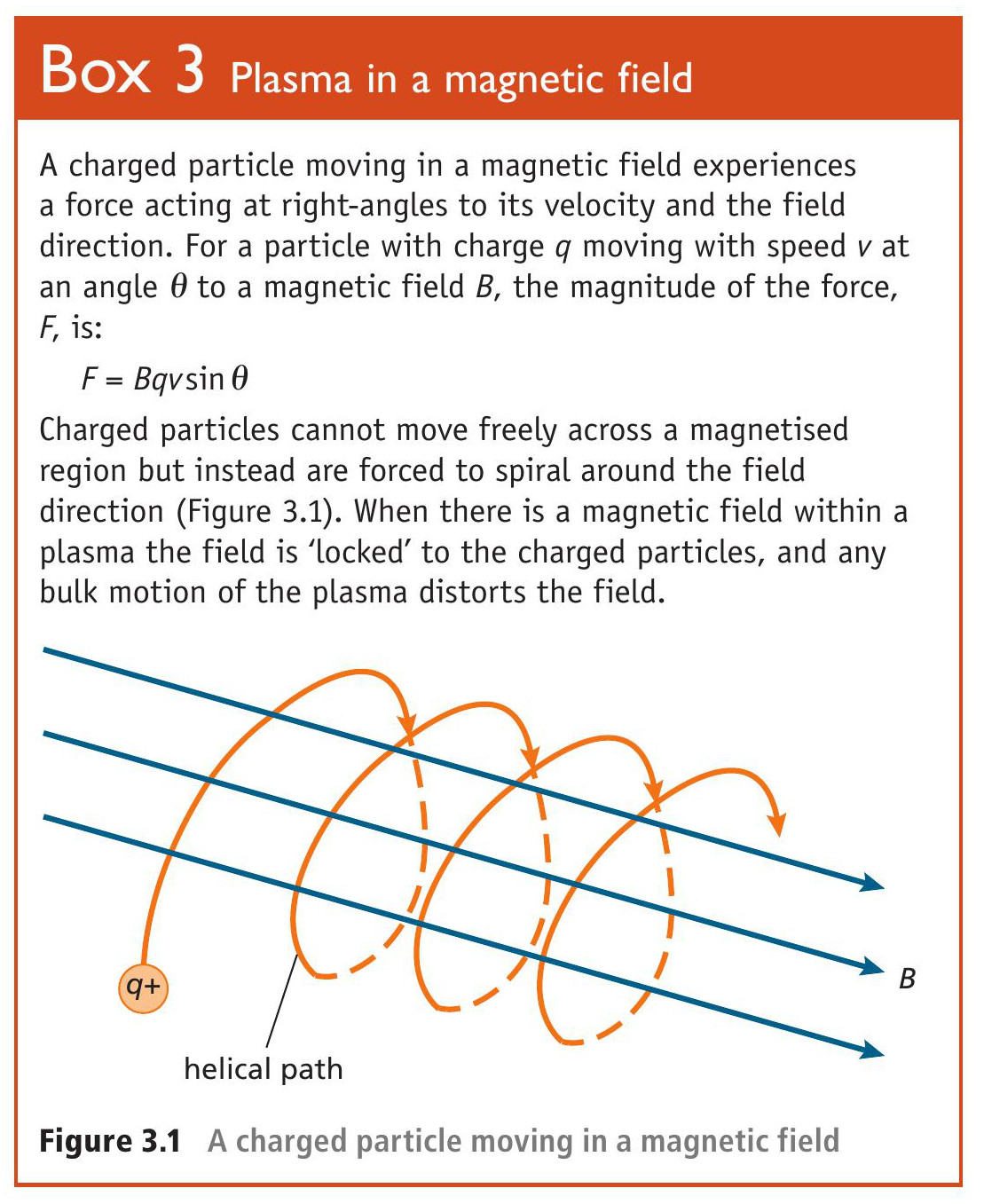
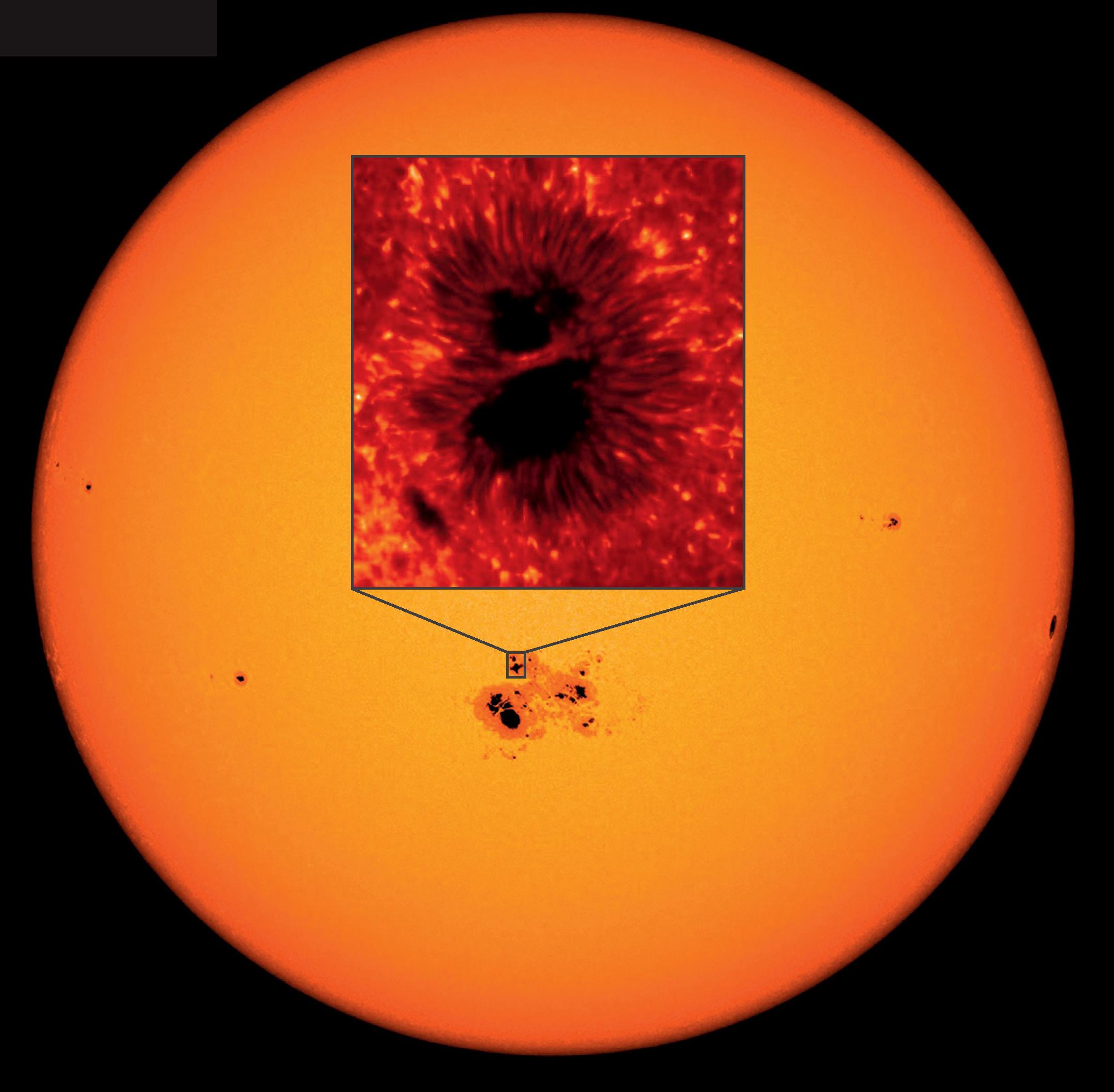
Sunspots
Sunspots appear as dark blemishes on the solar disc. They were first observed in 1610 when Galileo Galilei, Johann Fabricius and Christopher Scheiner independently observed dark spots on the face of the Sun and explained them as clouds floating in the Sun’s atmosphere. Galileo found that the spots appeared to move across the solar disc, day by day, which suggested to him that the spots were a part of the Sun and that they moved as the Sun rotated.
Each sunspot has a dark central region (called the umbra) surrounded by a less dark, filamentary region (the penumbra). The diameter of the penumbra is about 2.5 times that of the umbra. The strong magnetic field in the umbra reduces the density of the plasma, making the sunspots more transparent than the photosphere, so they appear as holes when observed near the edge of the Sun’s disc.
Although sunspots appear dark, they do emit radiation. They are strongly magnetised, which inhibits convection as plasma cannot easily move across a magnetic field, so sunspots are cooler and less bright than their surroundings.
The number of observed sunspots varies on a timescale of years. About every 11 years the solar magnetic field completely flips, so the Sun’s magnetic north pole becomes a magnetic south pole, and vice versa. As the field changes, so do the features of the solar surface. A peak in the sunspot count is referred to as a time of solar maximum, whereas a period with fewest sunspots is a solar minimum.
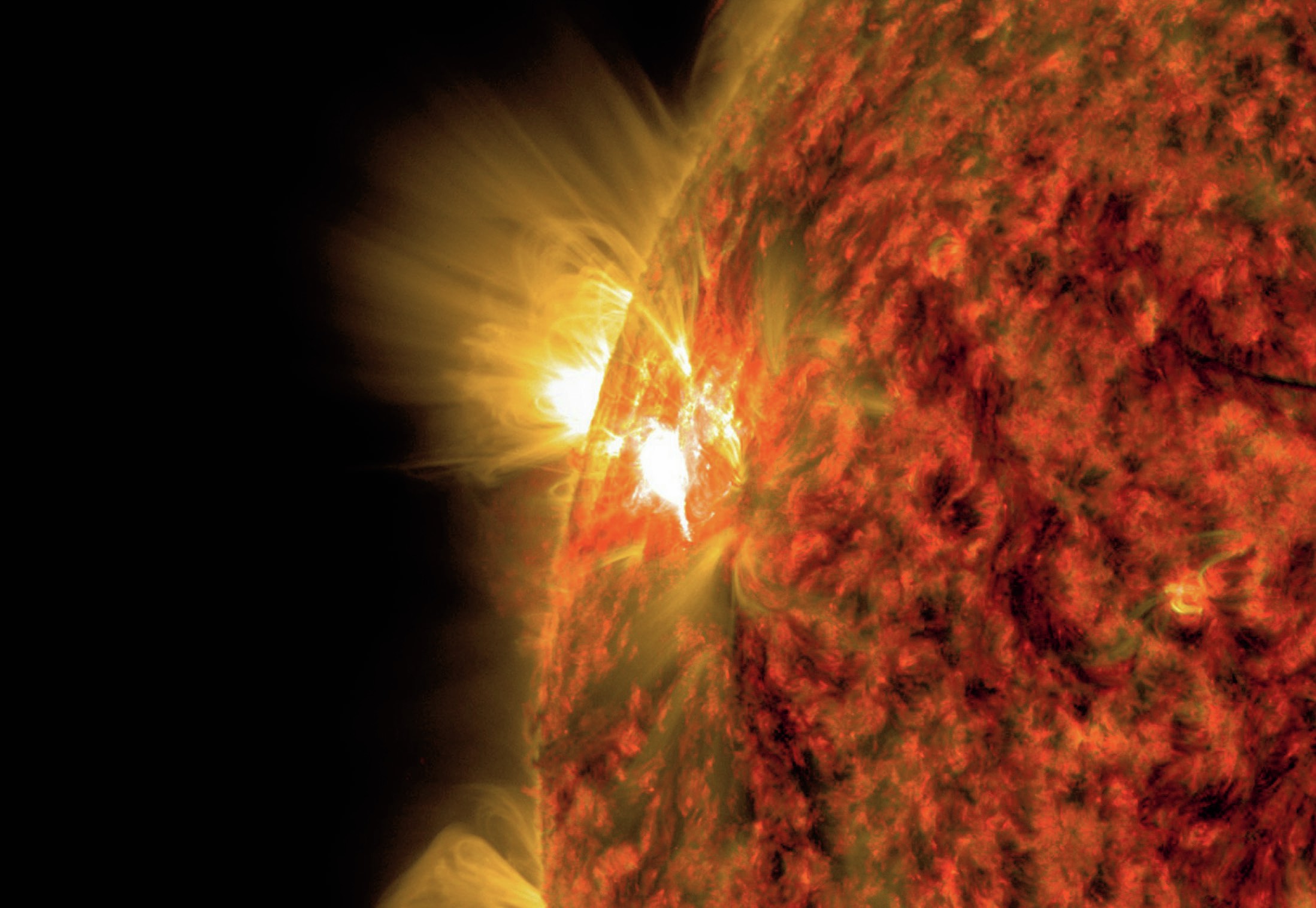
Solar prominences
Solar prominences are giant loops of plasma that extend far outward into space along the Sun’s magnetic field lines. A prominence is a region of cool plasma (~104K) suspended in the hot corona (106K). Prominences can be seen during solar eclipses, and can be many times larger than Earth.
During peak solar activity plasma enters the corona through the chromosphere. This ejected plasma cools and condenses, and flows gradually downward towards the chromosphere along the magnetic field lines, appearing as a dark filaments on the solar disc. The flow of ions means that the prominences carry strong electric currents.
Solar flares
Solar flares are another dramatic type of solar activity — a sudden and intense increase in brightness. These were discovered in 1859 when Richard Carrington and Richard Hodgson were observing sunspots and each, independently, saw a pair of brilliant white ribbons flash, only for 15 minutes, across the umbra.
A flare occurs when a huge amount of hot plasma erupts from the photosphere in a very short interval of time. They are observed as small, star-like, bright spots emerging suddenly near a large sunspot or a group of sunspots. These spots expand explosively for few minutes and cool down quickly. The plasma travels outwards though the solar system, and can affect us on Earth, for example by disrupting radio communication.
Conclusion
This article has given only a brief overview of the Sun. Studying the Sun is important because it drives the climate on the Earth, and research has shown a correlation between Earth’s ice ages and solar activity. To find out more about the Sun and its influence, see the ‘Resources’ box for this article.
PhysicsReviewExtras
Get practice-for-exam questions based on this article at www.hoddereducation.co.uk/physicsreviewextras
RESOURCES
These PHYSICS REVIEW articles explain how solar activity can affect Earth:
Rourke, J. (2017) ‘Forecasting space weather’, PHYSICS REVIEW Vol. 27, No. 2, pp. 2–6.
Street, S. (2012) ‘Superstorm’, PHYSICS REVIEW Vol. 21, No. 3, pp. 2–5.





